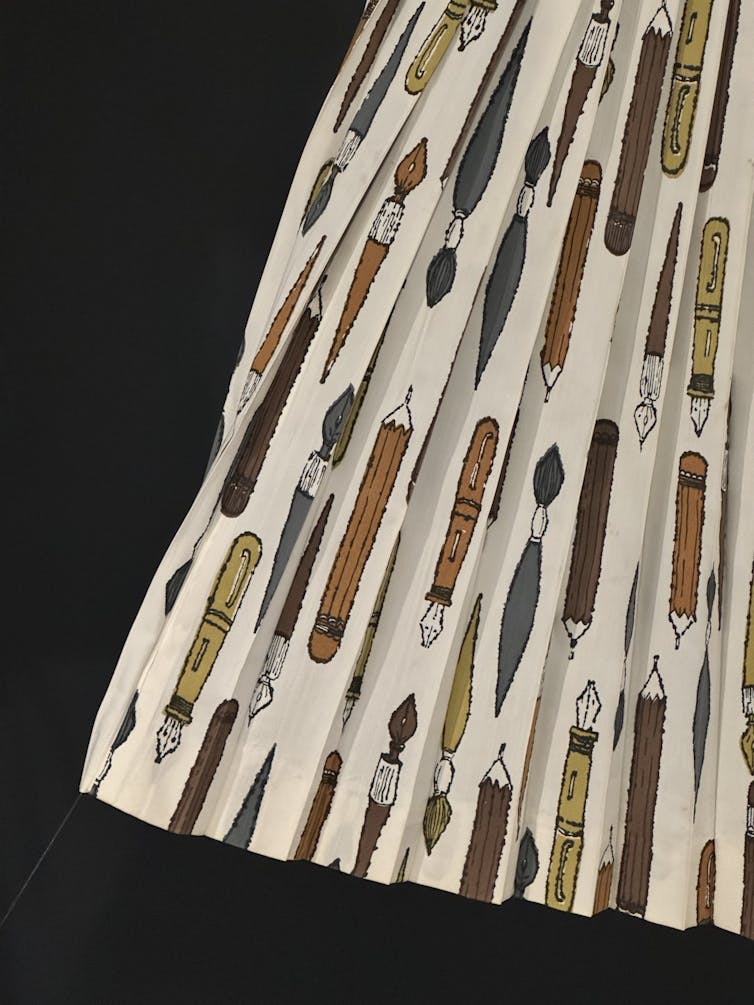The printed materials created by Andy Warhol throughout the Nineteen Fifties and Nineteen Sixties reveal the artist’s recurring fascination with quirky motifs rendered in his trademark inky strains. This contemporary, thrilling type was acquired whereas working as a industrial illustrator in New York’s fledgling promoting trade.
Earlier than establishing himself because the seminal affect within the pop artwork motion – finest recognized for his silkscreens of Nineteen Sixties cultural and client icons reminiscent of Marilyn Monroe and Campbell’s soup – Warhol had a particularly profitable profession in illustration and graphic design.
However it’s only not too long ago that his industrial textile designs have been unearthed – few even realised they had been a part of the artist’s story. Now these designs are being showcased in Andy Warhol: The Textiles on the Dovecot, a design and textile gallery in Edinburgh, that includes 35 of Warhol’s whimsical patterns.

© 2024 The Andy Warhol Basis for the Visible Arts, Inc.
Creating the look
Issues begin off strongly exhibiting lithographs and early textile designs on paper, juxtapositioned with lengths of repeating-pattern materials and classic clothes. These set the scene for a chronological show of Warhol’s illustrative method to textile design, and the interpretation of his imagery onto a wide range of clothes provides the exhibition a nostalgic thrift-shop attraction.
A number of cool little particulars abound. For instance, vistors learn the way a typo from an promoting job misspelled his unique title – Warhola – chopping off the “a”, by accident creating the title that might turn out to be ceaselessly synonymous with pop artwork. That is mirrored within the inclusion of a printed promoting mail-shot he designed for the Moss Rose Manufacturing Firm in 1949 that includes his Czechoslovakian start title in full.

© 2024 The Andy Warhol Basis for the Visible Arts, Inc.
The beginning of the exhibition focuses on the timeless but largely unrecognised means of changing art work on paper into patterned materials for clothes. “Blissful Bug Day” (1955-56), a textile print produced by D.B. Fuller & Co, highlights the journey of an illustration because it interprets to a repeating sample that finally turns into a swimwear piece typical of the Nineteen Fifties.
Warhol’s course of is well known all through the exhibition by inspecting the totally different phases of textile making and clothes manufacturing. All through vogue historical past, it’s typically a daring or placing print that “makes” a garment, although textile designers are hardly ever acknowledged. Extra normally it’s vogue designers who obtain the acclaim.
Turning this on its head, there’s a lot referencing across the textile producers creating the materials, and far much less give attention to garment designers or vogue boutiques that might have stocked the items.

© 2024 The Andy Warhol Basis for the Visible Arts, Inc.
Because of their classic nature, a number of the hanging material items and clothes on show would look simply as at house in a charity store window. However it’s the garment particulars that present a number of the most visually pleasing and thrilling use of textiles within the exhibition area.
“Pens, pencils and brushes” (1956) and “Fragrance and scent bottles” (1958-59) are two lovely examples of printed materials exhibiting how intelligent manipulations create fantastic results by distorting the uniformity of graphic patterns by material pleating, for instance.
Typically utilizing quirky motifs reminiscent of socks, potted vegetation and ice cream cones, Warhol rendered them with a longtime “blotted line” method or a easy print stamp. These vibrant quirky designs introduced some much-needed color to a colorless post-WWII America, exuding a contemporary, optimistic and light-hearted high quality.

Andrew Unangst / Alamy
However Warhol’s image-making might simply be mistaken for the work of a recent youngsters’s ebook illustrator and would look equally at house on a pattern-obssessed Instagram account in 2024.
Like many different skilled designers, Warhol typically used variations and combos of concepts that he had employed in different graphic works. The exhibition highlights the expert skilled apply of producing material colourways with repeating patterns, together with an instance of material with giant vibrant butterflies (1955-56), once more produced by D.B. Fuller & Co.
Discovering Warhol
Alongside the textiles and garment collections the exhibition additionally consists of big back-lit black and white portraits of Warhol that act as much-needed context for the movie star artist who was then simply discovering his method together with his industrial designs.
This was lengthy earlier than earlier than he launched into his Manufacturing unit exploits the place he created experimental works throughout a wide range of media that might garner him fame and notoriety, and safe his place in artwork historical past books.

© 2024 The Andy Warhol Basis for the Visible Arts Inc.
The ultimate items within the exhibition carry collectively what are believed to be his final industrial textile designs, translated into predominantly silk and artificial materials by the Stehli Silks Co, courting from 1962-63. These reveals show a lot nearer hyperlinks to his pop artwork oeuvre, with clashing color and extra modern tradition references for motifs, reminiscent of pretzels on printed silk.
As a textile designer who has seen quite a lot of exhibitions on this area, it’s arduous to not evaluate this show with the sweetness and technical innovation behind different Dovecot exhibits. For me these excessive factors embrace Making Nuno, which showcased the work of Japanese textile designer Sudō Reiko a few years in the past, and the enduring method to wallpaper sampling in The Artwork of Wallpaper: Morris & Co.
Maybe in contrast to these exhibitions, Andy Warhol: The Textiles doesn’t declare to current the pop artwork pioneer as a pioneer of textile design too. Nevertheless it does carry a most pleasant and contemporary perspective to his work, revealing the DNA and origins of Warhol’s iconic type.